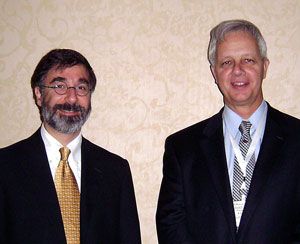An Overview of CBI's 2nd Annual Oncology Clinical Trial Summit
The Center for Business Intelligence (CBI; Woburn, MA) provided an opportunity this past September for oncology professionals to gather together and talk shop. The event, CBI’s 2nd Annual Oncology Clinical Trial Summit, was held the 18th and 19th at the Hilton in Old Town Alexandria, VA-about a fifteen minute Metro train ride from the heart of DC.
In its second year, the Summit attracted more attendees (around 85), said program manager Daniel Dunn, who credited this year's strong content for the increase. What follows will highlight some of that content and the efforts being made across industry to improve oncology R&D.
Behind the times

Over the two-day event one fact became clear: There’s plenty of room for improvement. Today, 60% of investigational cancer drugs fail in Phase III; that’s a $100 million dollar loss to sponsors each time. In addition, it takes eight to 12 years to develop a drug and few succeed.
All things considered, the phrase an “antiquated thinking of how we develop medicine” seems relevant, and that’s how the Summit’s Keynote Speaker described the situation today. “We really need to go into the personalized [medicine] approach and need a major paradigm shift by introducing biomarkers into a clinical trial successfully,” said Samir Khleif, MD, chief of the cancer vaccine section at NCI and special assistant to the Commissioner, FDA.
Although around 400,000 peer-reviewed articles on biomarkers have been published, only a few are on cancer, according to Khleif, who specifically described the need for developing diagnostic, predictive, and metabolic biomarkers that are validated, reliable, and reproducible. “Biomarkers will provide and represent common good for patients,” he explained, “many groups are working on [it]...the good news is we’re making lots of progress.”
Disease state
The bad news? Unlike other diseases, cancer comes in many different varieties (skin, bone, etc.). As AstraZeneca’s Joseph Paul Eder, MD, so elegantly put it during the panel discussion that followed the keynote: “We don’t understand cancer and have very little idea [of] how to address it.”
Eder, senior director, clinical research discovery at AZ who served as event chairman, was joined for the 45-minute panel discussion by Grant Williams, executive director, clinical development, GlaxoSmithKline, and Yannis Jemiai, PhD, senior biostatistician, Cytel Inc. With Jemiai as moderator, the men, along with audience members, took turns sharing insights and ideas, including the following:
• Oncology probably produces more new molecular entities than any other therapeutic area
• Investigational duds are not being killed fast enough
• Real benefits could result from data pooling and sharing, such as FDA being able to improve disease models
• Industry’s mistake: trying to treat 2.5 million patients instead of successfully treating two dozen
• For adaptive trial design to work, subject enrollment has to slow down; however, pressure to enroll quickly usually exists.
Speaking of adaptive, when Jemiai asked whether this approach to trial design was a topic of conversation at audience members’ companies, only one person raised their hand. If we are to consider true one comment made near the end of the session-that if you’re not considering adaptive trials, you’re not in the 21st century-that lone hand supports Khleif's antiquated theory about cancer R&D.A word from Tufts
As for its future, Christopher-Paul Milne, JD, provided an overview of where he and his colleagues at Tufts, where he is associate director of the Center for the Study of Drug Development, see oncology R&D heading.
Although a lot of work is still being done with small molecules, the growth seems to be in biotech drugs, Milne explained-and the cancer market. He quoted figures from Business Week projecting worldwide drug sales could reach almost $70 billion by 2010. Such a healthy return on investment is miniscule compared to the $219 billion spent on cancer care each year (and the World Health Organization predicts global cancer rates could increase 50% by 2020).
So, what needs to be done in terms of improvements? According to Milne, government needs to step up. “Regulators have to become our partners in collaboration,” he said, “and not just the overseers.” An example of this kind of effort is found overseas, where industry and the European Commission are splitting the bill to fund research, including in cancer and biomarkers. “Hopefully we can expect good things from the other side of the pond,” Milne said.
Machine assistance
Perhaps the real eye opener came during the first of two presentations on the use of imaging in cancer trials. That’s when Novartis’ Haren Rupani, MD, guaranteed that two generations from now people will describe the way we treat cancer as barbaric.
“As of today," he said, "cancer is smarter than us.” To treat cancer, we need to understand it. To understand it, we need to know how it behaves, and that, according to Rupani, is the paradigm shift industry is facing when it comes to imaging: How is the tumor behaving?
The global head of oncology imaging at Novartis discussed the company’s use of early exploratory imaging in cancer trials and how it approaches the practice, which for Rupani and his team includes frequent communication with CROs and finding out up-front what team members expect from imaging.

But while it holds great promise, problems abound: it's expensive, nothing is standardized (there are no FDA-approved response or threshold criteria), and clinical trials are less than 1% of imaging companies’ business-a thorn in industry’s side because of the lack of balance in supply and demand. Industry needs vendors much more than vendors need industry. Things are changing though.
Planting the seed
Leading the effort is the National Cancer Institute; in fact, NCI's goal is to change the culture in the field of imaging so that sharing becomes the norm. “Not just the images, but the results,” explained Laurence Clarke, PhD, chief of the imaging technology development branch, cancer imaging program, at the Institute. Academic scientists and vendors are also part of the equation for change.
And at the bottom of it all? Dollars. “The only way to change a culture is to provide money,” said Clarke. For NCI that has meant spending millions on the Network for Translational Research (http://imaging.
cancer.gov/programsandresources/specializedinitiatives/ntroi). Clarke described it as funding “the next generation of image modality” in cancer-one that builds bridges (partnerships) between academia and industry and hopefully gains the interest of vendors, whose cooperation it appears is critical to the success of imaging in cancer R&D.
The face of change
Another force on the scene with NCI backing is the Coalition of Cancer Cooperative Groups http://www.cancertrialshelp.org/. Its mission is four-fold: education, outreach, advocacy, and research. And when it comes to research, the Coalition is a matchmaker of sorts. In this case: partnerships. “Federal funding is shrinking,” said Diane Colaizzi, senior advisor for program development at the Coalition, “so we’re working with NCI on how [cooperative] groups and industry can work together by easing up its restrictions.”
In addition to breaking down walls, the nonprofit organization is also working to change the public’s perception of clinical trials. That includes spreading the word that they’re not a “last resort” for cancer patients. “We’re still dealing with an American public uninformed about trials as an option for treatment,” said Colaizzi, who along with the Coalition is trying to change that.-Kerri Nelen
Empowering Sites and Patients: The Impact of Personalized Support in Clinical Trials
November 26th 2024To meet the growing demands of clinical research, sponsors must prioritize comprehensive support models, such as clinical site ambassadors and patient journey coordinators, who can address operational challenges and improve site relationships, patient satisfaction, and overall trial efficiency.
FDA Finalizes Decentralized Clinical Trial Guidance
November 25th 2024The FDA's guidance is part of a broader effort to modernize clinical trials, improve efficiency, reduce participant burden, and expand access, particularly for underrepresented populations and those in geographically or economically constrained areas.
In Focus: Addressing the Health Literacy Roadblock in Patient Recruitment
Published: November 15th 2024 | Updated: November 15th 2024With universal adoption of health literacy best practices slow going over the years, advocates are redefining the term to encompass much more of what health-related communication requires beyond simply words.